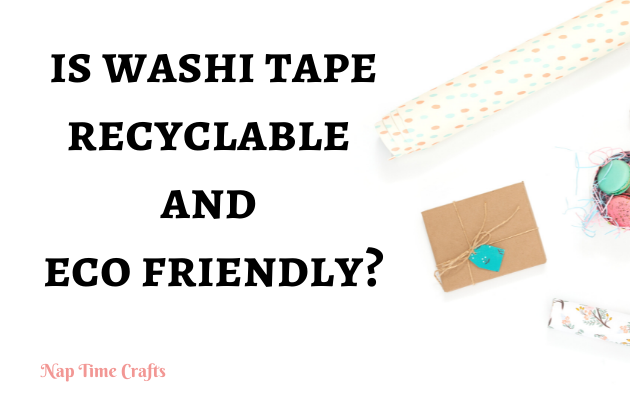Is Washi tape recyclable and eco-friendly?
Washi tape is a recyclable, eco-friendly option. Most washi tapes are made using sustainable practice, and they have biodegradable paper backings and rubber adhesive. Washi tapes are also durable enough to be used more than once, making them go beyond a single-use product.
In this article, we will look at how washi tape can be recycled and reused. We will also explore what makes this type of tape eco-friendly and where washi tape falls short. Check out the end of the article for other recyclable and eco-friendly tape options.
This article may contain affiliate links which pay a commission and support this blog. Thank you for your support!
Is Washi Tape Recyclable?
Washi tape is generally considered recyclable, but this status can change depending on what your recycling contractor offers. Some request that you do not include tapes of any kind, including recyclable options.
Most recycling companies still accept tape in moderation. The recycling process for paper effectively removes contaminants like glues or plastics.
When paper is recycled, it is all pulped and then soaked in chemicals. These chemicals cause the glues and plastics on the tape to detach and float to the surface, along with any plastic tapes or other contaminants.
The washi tape paper should remain with the other papers, making it just as recyclable as other products.
Washi Tape is Reusable
Washi tape is durable enough to be used multiple times, unlike many other tapes. Some may have an adhesive that is too durable and rips the paper, while other tapes may lose their stickiness.
Washi tape has the perfect blend of durability and gentle adhesion that allows you to remove it from the paper and stick it somewhere else. The tackiness does decrease with use, but this prevents you from grabbing a new piece of tape if you make a mistake.
Is Washi Tape Environmentally Friendly?
Traditional washi tape is an extension of Japanese papermaking. The resources used and the conventional manufacturing process makes it a more sustainable product than many western alternatives.
Many western tapes are made from plastic, and even those made from trees are less eco-friendly. The western process for making this paper involves felling a tree after it has grown for at least 20 years.
Washi tape is primarily made from parts of trees, shrubs, and other plants, including:
- Mulberry
- Gampi
- Hemp
- Mitsumata
Instead of killing these plants, manufacturers can use bark and branches to make pulp. This is then shaken out onto a screen to form a sheet.
The rubber adhesive attached to the bottom of the paper is usually made of rubber that is harvested from rubber trees. This material is sustainably harvested by tapping into the trees and collecting the liquid.
Washi tape is also biodegradable. Unlike tapes that use plastic, the natural fibers of washi tape allow it to break down naturally over time.
Negative Environmental Impacts of Washi Tape
Because washi tape has gained popularity over the years, many options are made in a factory instead of by hand. They may retain the same recyclability and eco-friendly features, but this form of production has a larger carbon footprint.
The dyes used in washi tape production are also challenging to determine the source. These can affect biodegradability, and there is little way to calculate the impacts of the dyes.
Keep an eye out for any tapes that mimic washi-tape without the same sourcing and manufacturing processes. Many mainstream brands have similar options that do not use sustainable papers or natural adhesive, and they do not have the same benefits as traditional washi tape.
Recyclable and Eco-Friendly Alternatives to Washi Tape
You might not always have access to washi tape, or it may not be suitable for your taping needs. Here are some other tapes that are also recyclable and eco-friendly.
Masking Tape
Paper masking tapes are also easy to remove, but they are not as durable as washi tape. Most masking tape has its own uses, and they do not come in as many bold colors and patterns. While not every recycling center will accept it, many are made and marketed as recyclable.
Paper Tape
Paper will always be a better choice than plastic, and several manufacturers are moving towards this sustainable option. While most paper tapes are brown, new colors and patterns are on the rise. Paper tape does not usually remove well, and packing varieties may be reinforced with filaments that render them unrecyclable.
Cellulose Tape
Cellulose tape is an excellent alternative for anyone needing the traditional plastic tape look. These tapes still look and feel like plastic tape, but they are biodegradable and have a less environmental impact.
Gummed Tape
You may see gummed tape referred to as “water-activated tape.” This is only sticky once you wet it, and many larger organizations use it for packaging. Gummed tape cannot be removed once it is in place, but most varieties are paper-based and recyclable.
Summary: Is Washi tape recyclable and eco friendly?
As you can see, Washi tape is recyclable and eco friendly. Traditional Japanese tape is more sustainable than western manufacturing process. However, your local recycling center may not accept tape.
Most Washi tape is paper, which is recyclable. The process for recycling paper does remove the sticky adhesive. Therefore, Washi tape is considered recyclable as long as your recycling center accepts tape.
Other types of tapes that are recyclable include:
- Masking Tape
- Paper Tape
- Cellulose Tape
- Gummed Tape
